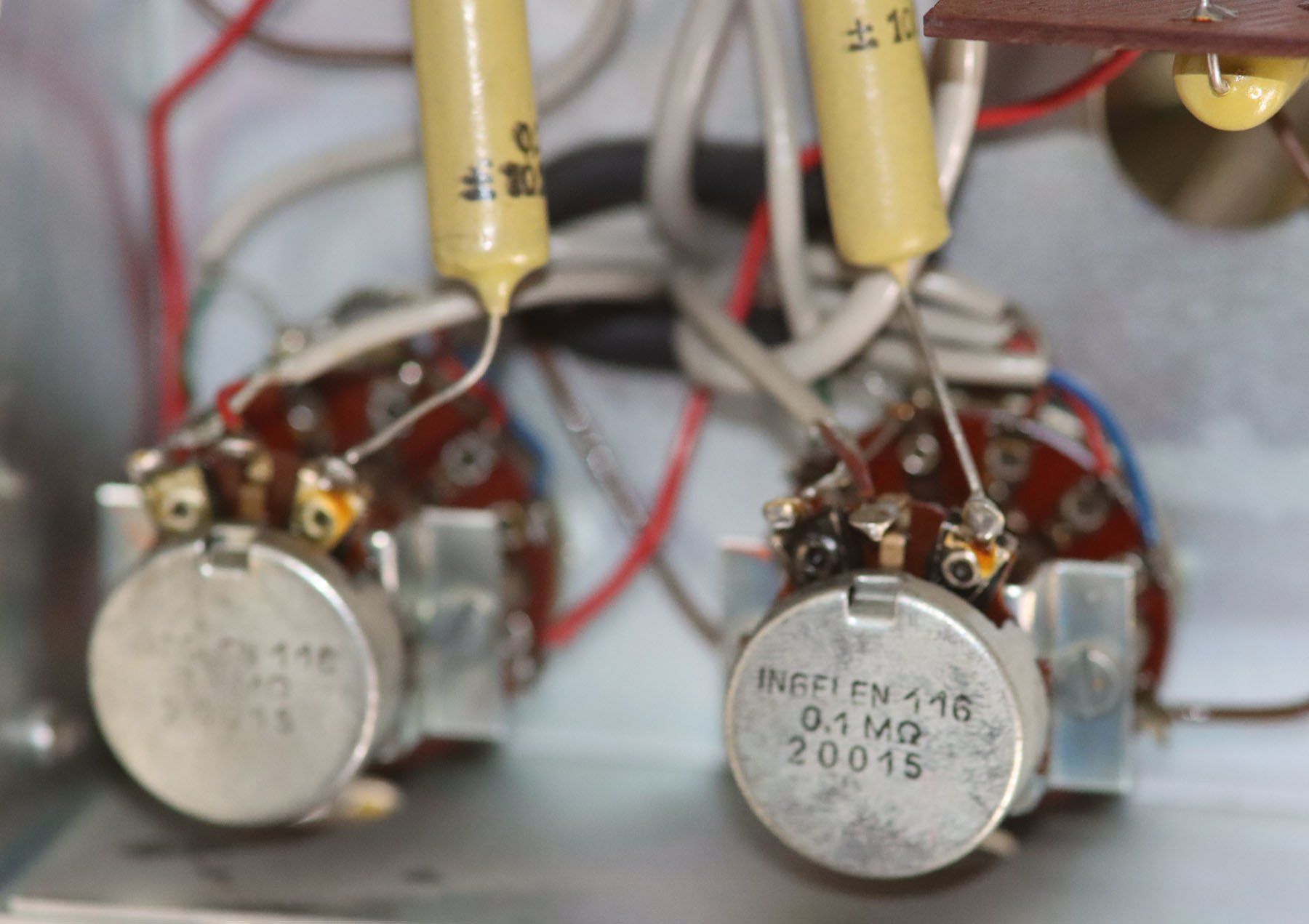Revox G36
Built from 1963 to 1967
The Revox G36 was the crowning achievement in the development of tube tape recorders.
For the first time, reels with a diameter of 26.5 cm could be loaded. The Revox F36 and its predecessors could operate with reels with a maximum diameter of 22 cm. The Revox G36 was the first to use a synchronous motor as the sound motor.
The Revox G36 had two versions of mechanical tape end switches. Up to model number 36,500, a microswitch was used. From model numbers 36,501 to 58,000, a lever operated gold-plated wire contacts.
Starting with serial number 58,001, the tape end was scanned optoelectrically. A fiber optic cable through the right pulley and the photoresistor in the stationary bolt was a rather strange construction—more on that later!
The design of the Revox G36 is truly ingenious. Ultra-long rods for the potentiometers and rotary switches ensure short signal paths, as do the tubes arranged in a row, along with the associated resistors and capacitors. Not only is the machine a joy to use, but its sophisticated design also makes servicing a pure joy. And all this back in 1963—what a vintage! :-D
Technical data
the Revox G36
Belt speeds:
9.5 cm/s and 19 cm/s synchronous capstan motor
Wow and flutter:
at 19 cm/s better +/- 0.1%,
at 9.5 cm/s better +/- 0.15%, hardly worse than a Revox A77 or B77
Frequency response across band:
40 Hz to 18 kHz + 2 dB to - 3 dB at 19 cm/s
40 Hz to 12 kHz + 2 dB to - 3 dB at 9.5 cm/s, Okay, the 12 kHz hurts from today's perspective!
Max. coil diameter:
26.5 cm (10.5")
Forward and rewind time:
120 seconds for 1000 m tape
Equalization:according to IEC
70 µs / 3180 µs at 19 cm/s
140 µs / 3180 µs at 9.5 cm/s
Noise level:
2-track (k = 3%) 55 dB
4-track (k = 3%) 52 dB
Distortion factor:
max. 3% at full output
Dynamics over band: (k = 3%)
2-track:
55 dB at 19 cm/s
53 dB at 9.5 cm/s
4-track:
52 dB at 19 cm/s
50 dB at 9.5 cm/s
Inputs per channel:
1. Microphone 3 mV Ri = 500 kΩ (max. 600 mV)
2. Radio 50 mV Ri = 1 MΩ (max. 10 V)
3. Diode 3 mV to 50 mV Ri = 47 kΩ (adjustable)
Outputs:
2 cathode followers 2-track Ua = 0.7 V
4-track Ua = 0.5 V
1 speaker 5 Ω, 6 W
Built-in speaker:
21 cm diameter, switchable
Tube assembly:
4 x ECC81, 1 x ECC 82, 5 x ECC83, 2 x ECL86
Semiconductor assembly:
2 transistors, 5 silicon diodes, 3 selenium rectifiers
Mains voltage:
110, 125, 145, 220 and 240 V, 50 Hz
Power consumption:
approx. 120 VA
Weight:
20kg
Mass:
Suitcase: 47.7 x 34.1 x 29.5 cm
Chassis: 54.5 x 39.5 x 27.0 cm with 26.5 cm coils
Details
to Revox G36
Component arrangement
There's order here. Fantastic, everything in perfect order, the layout must be unique. If you're familiar with other devices, you'll truly appreciate this design. Any errors can be quickly located and fixed just as quickly.
burning passion
The relationship between tubes and transistors, or rather semiconductors, is similar to that of a record and a compact disk.
Everyone knows that tubes have more distortion - and yet, tubes sound better. Everyone knows that the CD has better technical features - and yet the record, with all its disadvantages, sounds better!
rocker switch
Two pushbuttons rotate the contacts of a rotary switch level. This allows you to select speeds of 9.5 cm/sec and 19 cm/sec, or to set channels 1, 2, or 1 and 2. The photo still shows the long brass tubes that operate the rotary switches and, like the Revox A77, carry the rods of the potentiometers inside – simply brilliant!
Potentiometers and switches
The Revox G36's rotary switches and potentiometers are located at the end of the brass tubes. This saves signal path and minimizes crosstalk. Especially since the resistors in tube technology are very high-impedance, but the capacitances are smaller and finer. There are advantages and disadvantages to everything!
left side of the G36
The Revox G36 can be turned on and off using the outer left rotary switch. The right rotary switch can be used to switch channels 1 or 2, or 1 and 2, to the internal speaker.
Above you can see the 5 function keys
VU meter
A real innovation with the introduction of the Revox G36 was the VU meter in the 36 series.
Belt end sensor
A small Plexiglas tube acts as a light guide through the right-hand fixed pulley, illuminated by a light source below the head cover. A photoresistor is embedded in the pulley bolt.
Once again without a head cover.
Well done, but with a lot of effort!
That is always the problem when making changes (improvements) to an existing system.
We're familiar with this from our counters: Pause 77, power-on delays, and VU meters A700. Drive control B77, quartz-controlled tone motor control, A77, B77, RCA jack spacing extension, and so on!
other Revox tape recorders




















